Nestled amidst the verdant hills of Bali, the Jatiluwih Rice Terraces stand as a testament to the harmonious blend of nature, culture, and sustainable agriculture. Their intricate design, cultural significance, and breathtaking beauty have captivated visitors from around the world.
As we delve into the tapestry of the Jatiluwih Rice Terraces, we will explore their history, design, and agricultural practices. We will uncover the cultural traditions that have shaped these terraces and witness the challenges and opportunities facing farmers in preserving this UNESCO World Heritage Site.
Overview of Jatiluwih Rice Terraces
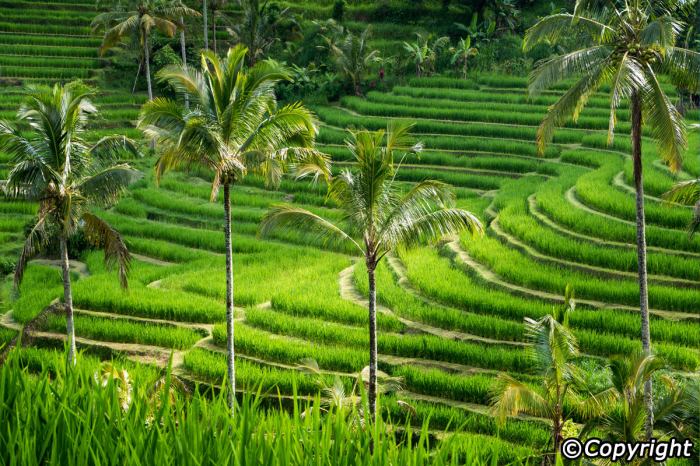
Jatiluwih Rice Terraces, a UNESCO World Heritage Site, are a stunning spectacle of emerald-hued paddy fields cascading down the slopes of Mount Batukaru in Bali, Indonesia. The terraces, crafted by generations of Balinese farmers, embody the island’s harmonious relationship between nature and culture.
The terraces, spanning over 600 hectares, are an intricate patchwork of rice paddies, irrigation channels, and sacred temples. Their unique layout, shaped by the local “subak” irrigation system, ensures equitable water distribution and symbolizes the communal spirit of the Balinese people.
Historical Significance
The Jatiluwih Rice Terraces have a rich history dating back to the 9th century. The Balinese people, guided by the principles of Tri Hita Karana (harmony between humans, nature, and the divine), developed the “subak” irrigation system that has sustained the terraces for centuries.
Cultural and Agricultural Practices, Jatiluwih rice terraces
The terraces are not merely agricultural marvels but also embody the cultural and spiritual beliefs of the Balinese people. Rituals and ceremonies accompany every stage of the rice cultivation cycle, from planting to harvesting, reflecting the deep connection between the Balinese and their land.
Geographic Location and Landscape
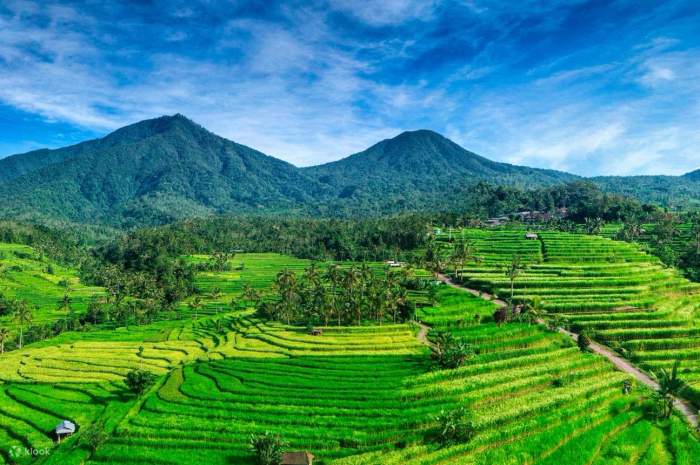
The Jatiluwih Rice Terraces are located in the Tabanan Regency of Bali, Indonesia. They are situated on the slopes of Mount Batukaru, a dormant volcano that rises to an elevation of over 2,200 meters. The terraces cover an area of approximately 600 hectares and are divided into thousands of individual plots.
The surrounding landscape is characterized by lush tropical vegetation, rolling hills, and sparkling rivers. The terraces themselves are a testament to the ingenuity and hard work of the local farmers, who have carved these intricate patterns into the landscape over centuries.
Adaptation to Climate and Topography
The Jatiluwih Rice Terraces have adapted to the local climate and topography in several ways. The terraces are built on a series of slopes that face north, which maximizes their exposure to sunlight. The terraces are also irrigated by a complex system of canals and ditches that bring water from the nearby rivers.
The terraces are designed to retain water and prevent erosion, even during heavy rains.
Tourism and Cultural Significance
The Jatiluwih Rice Terraces have gained prominence as a significant tourist destination, attracting visitors from around the world. Their picturesque beauty and cultural significance make them a must-visit destination for nature enthusiasts, cultural explorers, and those seeking tranquility.
Beyond their aesthetic appeal, the terraces offer a unique opportunity for visitors to immerse themselves in the local culture. Various cultural activities and experiences are available, such as traditional dance performances, cooking classes, and guided tours led by local farmers.
Impact of Tourism
The influx of tourism has had a positive impact on the local community. It has created job opportunities in the tourism sector, supported local businesses, and promoted the preservation of the terraces. The income generated from tourism has also contributed to the improvement of infrastructure and the overall well-being of the community.
Agricultural Practices and Sustainability
The Jatiluwih Rice Terraces are a testament to the ingenuity and agricultural expertise of the Balinese people. Traditional farming practices have been passed down through generations, ensuring the sustainability of the terraces and the livelihoods of the local farmers.
Challenges and Opportunities
Farmers in Jatiluwih face several challenges in maintaining sustainable farming practices. These include:
- Climate change and its impact on water availability and crop yields
- Pests and diseases that can damage crops
- Competition from imported rice
Despite these challenges, there are also opportunities for farmers to improve their sustainability. These include:
- Adopting organic farming practices
- Developing new markets for their products
- Working together to share knowledge and resources
Biodiversity and Environmental Conservation
The Jatiluwih Rice Terraces are home to a wide variety of plants and animals. The terraces provide a habitat for birds, insects, and other wildlife. The terraces also help to protect the watershed and prevent erosion.
Design and Architecture: Jatiluwih Rice Terraces
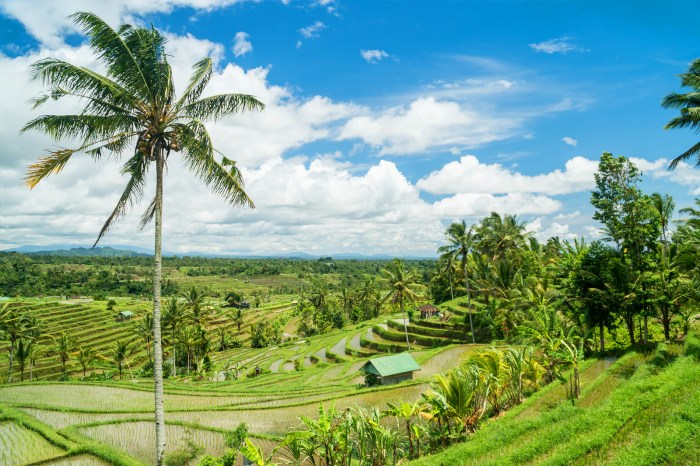
The Jatiluwih Rice Terraces showcase an intricate design and architecture that is both aesthetically pleasing and functionally efficient. The terraces are constructed using a combination of engineering techniques and irrigation systems that have been passed down through generations of Balinese farmers.
Engineering Techniques
The terraces are built on steep slopes, and the engineering techniques used to construct them ensure their stability and durability. The terraces are built using a system of retaining walls made of volcanic rock, which helps to prevent erosion and landslides.
The walls are constructed in a stepped pattern, which helps to distribute the weight of the water and soil evenly.
Immerse yourself in the tranquil beauty of Jatiluwih Rice Terraces, a UNESCO World Heritage Site. Stroll amidst emerald-hued paddies that cascade down the hillsides, creating a breathtaking tapestry of nature’s artistry. Escape into a world of serenity, where the gentle breeze whispers through the rice stalks and the vibrant sunsets paint the sky with hues of gold and crimson.
As you delve into the allure of Jatiluwih, discover Hello world! , a platform that connects you with travelers from every corner of the globe. Share your experiences and gain insights into diverse cultures, making your journey to Jatiluwih a truly enriching and unforgettable one.
Irrigation Systems
The Jatiluwih Rice Terraces are irrigated using a complex system of canals and ditches. The canals are fed by a nearby river, and the water is distributed throughout the terraces using a network of ditches. The irrigation system is designed to ensure that each terrace receives the water it needs to grow rice.
Aesthetic and Functional Aspects
The design of the Jatiluwih Rice Terraces is not only functional but also aesthetically pleasing. The terraces are laid out in a geometric pattern, which creates a visually striking landscape. The terraces are also planted with a variety of crops, including rice, vegetables, and flowers, which adds to their beauty.
Cultural and Historical Context
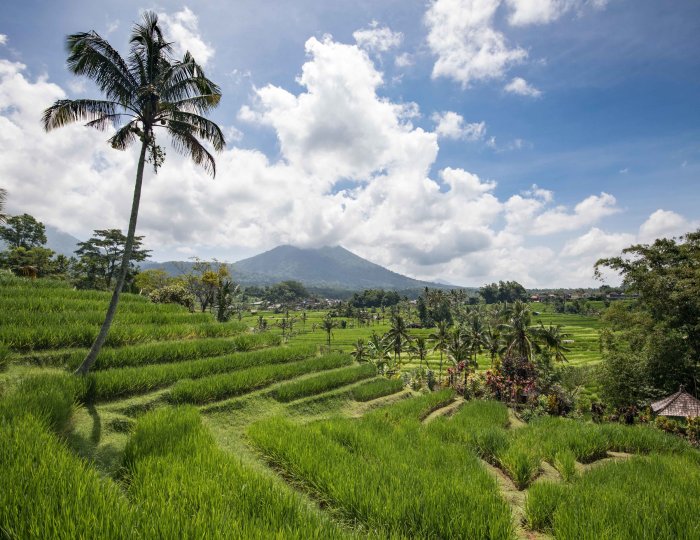
The Jatiluwih Rice Terraces hold immense cultural and historical significance for the Balinese people. They embody the harmonious relationship between humans and nature, reflecting the traditional Balinese concept of Tri Hita Karana, which emphasizes the balance between the spiritual, human, and natural realms.
Role in Balinese Culture and Traditions
The terraces have been an integral part of Balinese culture for centuries, providing sustenance and livelihoods for local communities. They are closely associated with the Subak irrigation system, a traditional cooperative system that ensures equitable water distribution among farmers. The Subak system is based on the principles of mutual respect, cooperation, and communal responsibility, and has been recognized by UNESCO as an Intangible Cultural Heritage of Humanity.
Historical Influences
The Jatiluwih Rice Terraces have evolved over time, influenced by various historical events. The terraces were first constructed during the 9th century by the Warmadewa dynasty, which ruled Bali from the 8th to the 10th century. The terraces were expanded and refined over the centuries by subsequent rulers, including the Gelgel dynasty and the Karangasem kingdom.The terraces have also been influenced by the Hindu religion, which has played a significant role in Balinese culture.
The terraces are often used for religious ceremonies and offerings, and the rice produced from the terraces is considered sacred.
Final Summary
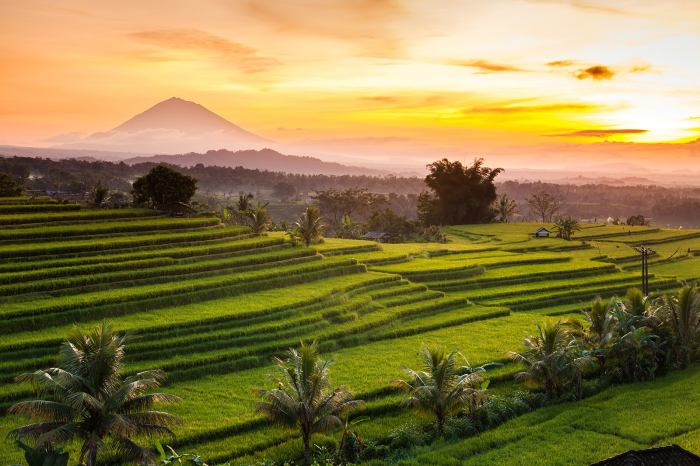
The Jatiluwih Rice Terraces are not merely a landscape; they are a living testament to the ingenuity, resilience, and cultural heritage of the Balinese people. As we bid farewell to these emerald slopes, we carry with us a deep appreciation for the beauty, sustainability, and cultural significance that make the Jatiluwih Rice Terraces a truly extraordinary destination.
FAQ Resource
What is the history behind the Jatiluwih Rice Terraces?
The terraces were first constructed in the 9th century using traditional Balinese irrigation techniques known as “subak.” The subak system ensures equitable water distribution and has played a vital role in the preservation of the terraces.
What makes the Jatiluwih Rice Terraces unique?
The terraces are renowned for their intricate design, which resembles a giant staircase cascading down the hillsides. They are also known for their lush greenery, which is maintained through sustainable farming practices that have been passed down through generations.
What cultural significance do the terraces hold?
The Jatiluwih Rice Terraces are deeply rooted in Balinese culture and religion. They are considered sacred and are often used for religious ceremonies and festivals. The terraces also play a significant role in the local economy, providing a livelihood for many farmers.